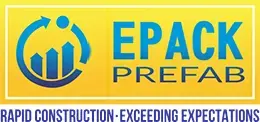No matter whether you are in a small or large-scale business, if you are looking for a cost-effective solution for your business, prefabricated buildings are the right choice for you. It not only helps save time but also reduces ecological pressure. In the past few decades, prefabricated buildings have evolved as a game changer for the construction world and altered the whole construction process.
In addition, it offers a myriad of benefits compared to traditional structures, making it efficient. In this blog, we are going to discuss how prefabricated buildings are the smart choice for modern construction projects. So, without further ado, let’s get started.
Prefabricated buildings: What exactly are they?
Prefabricated buildings, also known as modular or off-site construction, are made in factories using ready-made parts like walls, floors, and roofs. These parts are then taken to the building site and put together. This way of building is faster, saves money, and ensures better quality. Prefabricated buildings can be designed to fit different needs and are used for homes, offices, schools, and hospitals.
Choosing prefabrication means moving towards better and more eco-friendly building methods in today’s world. Some significant benefits of prefabricated buildings you should know are as follows:
Understanding the advantages of prefabricated buildings
Lessen construction time: Buildings and prefabricated constructions can be constructed more quickly. As a result, it completes much faster than building conventional or traditional structures. The majority of prefabricated building components are partially assembled, and on-site assembly is required during construction. It is the most suited type of construction for lower bandwidths because the entire project may be completed in a few short weeks. Stated differently, expediting the completion of construction results in a reduction of the time workers spend on the project, hence lowering labor costs.
Cost-effective: Prefabricated structures are constructed with recyclable and environmentally friendly materials, reducing the overall cost of construction. The inexpensive building supplies contribute to the reasonable prices. The outside construction of the prefabricated structures is done using traditional methods, guaranteeing the structure’s longevity.
Narrow ecological pressure: One of the primary sources of pollution is the construction industry. The materials heavily utilized in the construction process are the primary cause of pollution in the industry. One of the leading causes of greenhouse gas creation is thought to be cement. Bricks, the building block of conventional construction, are the primary source of air pollution, greenhouse gas emissions, and environmental pollutants. Because traditional buildings are built outside of factories, they also contribute to noise pollution.
How are prefabricated buildings better than traditional construction methods?
Prefab buildings, also known as modular construction, offer a significant advantage over traditional building methods and are remarkably swift to assemble. Unlike conventional construction, where parts are fabricated on-site, prefab components are meticulously crafted in a dedicated factory. This parallel construction approach allows workers to erect structures on-site while the parts are being manufactured, slashing the overall construction time by up to half. This accelerated timeline not only means you can start using the building sooner but also translates into substantial savings on labor costs.
Because everything’s made in a factory, there’s less waste of materials and less need for lots of workers. Additionally, factories can make a bunch of parts all at once, which means they can get discounts on buying stuff in bulk. So, if you’re building something big or you’re on a tight budget, prefab is an intelligent choice.
Prefab buildings are not just about speed and cost-efficiency; they also deliver on quality. Manufactured in a controlled factory environment, every component is produced to precise specifications, minimizing the risk of errors. The use of standardized parts across all prefab buildings ensures uniformity in appearance and performance, enhancing their reliability and longevity.
Conclusion
Indeed, prefabricated buildings play an essential role in helping businesses thrive. It offers exceptional construction quality, cost-effectiveness, and increased environmental sustainability in addressing today’s industry needs. With their ability to streamline processes, reduce waste, and provide consistent results, prefab buildings describe a pragmatic approach for a wide range of construction endeavors. So, if you are planning for your next construction project and maintaining quality and sustainability, opt for prefabricated buildings.











